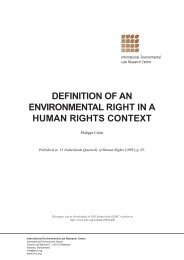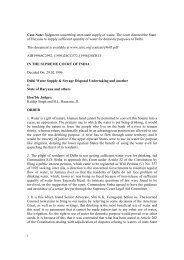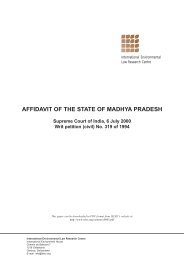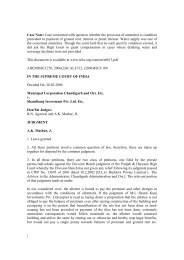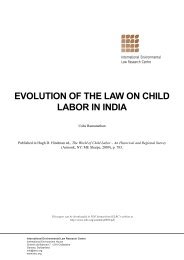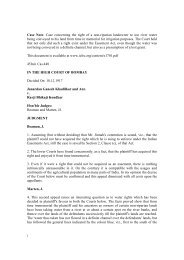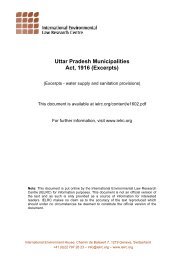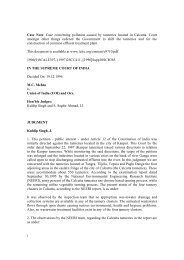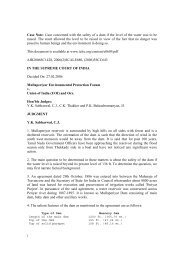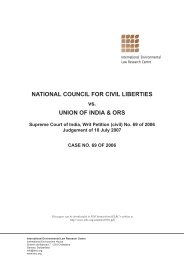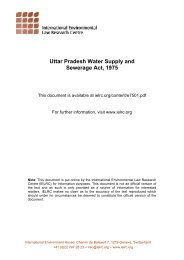Narmada Bachao Andolan vs. Union of India - International ...
Narmada Bachao Andolan vs. Union of India - International ...
Narmada Bachao Andolan vs. Union of India - International ...
You also want an ePaper? Increase the reach of your titles
YUMPU automatically turns print PDFs into web optimized ePapers that Google loves.
which, inter alia, consisted <strong>of</strong> a construction <strong>of</strong> a low dam. It was the case <strong>of</strong> the plaintiff that the construction <strong>of</strong>the project would destroy hundreds <strong>of</strong> thousands <strong>of</strong> trees and enormous grain, fish and other wild life will losetheir habitat and perish. It was contended that the defendants were proceeding in violation <strong>of</strong> law by not complyingwith the requirements <strong>of</strong> National Environment Policy Act, 1969 (NEPA). Plaintiff, inter alia, sought an injunctionfor restraining the undertaking <strong>of</strong> the project in violation <strong>of</strong> the said Act. The District Court held that notwithstandingthe substantial amount <strong>of</strong> work that had already been done in connection with the project, the failure to satisfy fulldisclosure requirement <strong>of</strong> NEPA injunction would be issued to halt any further construction until requirements <strong>of</strong>NEPA had been complied with; that even though there was no act like NEPA in <strong>India</strong> at the time when environmentalclearance was granted in 1987, nevertheless by virtue <strong>of</strong> Stockholm Convention and Article 21 <strong>of</strong> the Constitutionthe principles <strong>of</strong> Sierra Club decision should be applied.153. In <strong>India</strong> notification had been issued under Section 3 <strong>of</strong> the Environmental Act regarding prior environmentalclearance in the case <strong>of</strong> undertaking <strong>of</strong> projects and setting up <strong>of</strong> industries including inter-state river projects.This notification has been made effective from 1994. There was, at the time when the environmental clearancewhich was granted in 1987, no obligation to obtain any statutory clearance. The environmental clearnace whichwas granted in 1987 was essentially administrative in nature, having regard and concern <strong>of</strong> the environment in theregion. Change in environment does not per se violate any right under Article 21 <strong>of</strong> the Constitution <strong>of</strong> <strong>India</strong>especially when ameliorative steps are taken not only to preserve but to improve ecology and environment and incase <strong>of</strong> displacement, prior relief and rehabilitation measures take place pari passu with the construction <strong>of</strong> thedam.154. At the time when the environmental clearance was granted by the Prime Minister whatever studies wereavailable were taken into consideration. It was known that the construction <strong>of</strong> the dam would result in submergenceand the consequent effect which the reservoir will have on the ecology <strong>of</strong> the surrounding areas was also known.Various studies relating to environmental impact, some <strong>of</strong> which have been referred to earlier in this judgment,had been carried out. There are different facets <strong>of</strong> environment and if in respect <strong>of</strong> a few <strong>of</strong> them adequate data wasnot available it does not mean that the decision taken to grant environmental clearance was in any way vitiated.The clearance required further studies to be undertaken and we are satisfied that this has been and is being done.Care for environment is an on going process and the system in place would ensure that ameliorative steps are takento counter the adverse effect, if any, on the environment with the construction <strong>of</strong> the dam.155-156. Our attention was also drawn to the case <strong>of</strong> Tennessee Valley Authority v. Hiram G. Hill [437 US 153, 57L Ed 2d 117, 98 S Ct 2279] where the Tennessee Valley Authority had begun construction <strong>of</strong> the Tellico Dam andreservoir project on a stretch <strong>of</strong> Little Tennessee River. While major portion <strong>of</strong> the dam had been constructed theEndangered Species Act, 1973 was enacted wherein a small fish popularly known as the snail darter was declaredan endangered species. Environmental groups brought an action in the Unites States District Court for restrainingimpounding <strong>of</strong> the reservoir on the ground that such an action would violate the Endangered Species Act bycausing the snail darter extinction. The District Court refused injunction but the same was granted by the UnitedStates Court <strong>of</strong> Appeal. On further appeal the US Supreme Court held that the Endangered Species Act prohibitedthe authority for further impounding the river. The said decision has no application in the present case becausethere is no such act like the Endangered Species Act in <strong>India</strong> or a declaration similar to the one which was issuedby the Secretary <strong>of</strong> the Interior under that Act. What is, however, more important is that it has not been shown thatany endangered species exists in the area <strong>of</strong> impoundment. In Tennessee Valley Authority case it was an acceptedposition that the continued existence <strong>of</strong> snail darter which was an endangered species would be completelyjeopardised.157. Two other decisions were referred to by Shri Shanti Bhushan – Arlington Coalition on Transportation v.John. A Volpe [458 F.2d 1323 (1972)] and Environmental Defense Fund. Inc v. Corps <strong>of</strong> Engineers <strong>of</strong> UnitedStates Army [325 F.Supp.749 (1971)]. In both these decisions it was decided that the NEPA would be applicableeven in case <strong>of</strong> a project which had commenced prior to the coming into force <strong>of</strong> the said Act but which had notbeen completed. In such cases there was a requirement to comply with the provisions <strong>of</strong> NEPA as already noticedearlier. The notification under Section 3 <strong>of</strong> the Environment Protection Act cannot be regarded as having anyretrospective effect. The said notification dated 27 January 1994, inter alia, provides as follows:Now, therefore, in exercise <strong>of</strong> the powers conferred by sub-section (1) and clause (v) <strong>of</strong> sub-section (2)<strong>of</strong> Section 3 <strong>of</strong> the Environment (Protection) Act, 1986 (29 <strong>of</strong> 1986) read with clause (d) <strong>of</strong> sub-rule (3)<strong>of</strong> rule 5 <strong>of</strong> the Environment (Protection) Rules, 1986, the Central Government hereby directs that onand from the date <strong>of</strong> publication <strong>of</strong> this notification in the Official Gazette expansion or modernisation33



